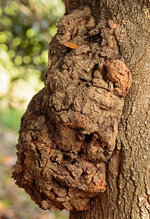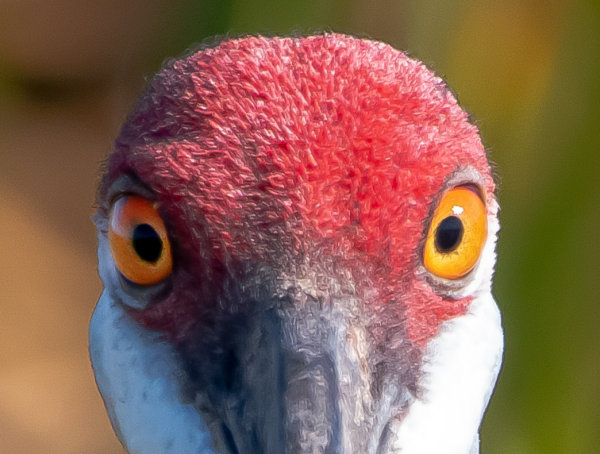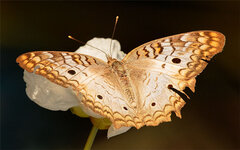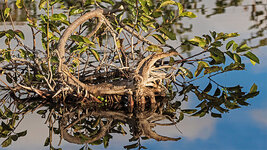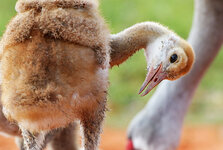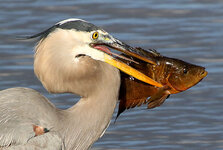I enjoyed your photos, thanks
You are using an out of date browser. It may not display this or other websites correctly.
You should upgrade or use an alternative browser.
You should upgrade or use an alternative browser.
The Birds and the Bees
- Thread starter Sylvanite
- Start date
Signed-In Members Don't See This Ad
Signed-In Members Don't See This Ad
Dalecamino
Local Chapter Leader
I am a fan of the Ducks, myself.
M R Ducks
O S M R
C M Ducks!
S I C M Ducks!
M R Ducks 2
O S M R
Sent from my iPhone using Penturners.org mobile app
C M E D B D eyes?:biggrin:
Dalecamino
Local Chapter Leader
Never get tired of seeing your awesome photos Eric.
jimm1
Member
Absolutely amazing. May I ask what your camera setting were?
Sylvanite
Member
Well, for bird-in-flight shots, possibly the most important camera setting was "AI-Servo" autofocus. That allows the camera to keep a bird in focus, even if it is flying towards the camera. That, combined with high-speed continuous shooting (for my camera, that's 10 frames per second) allow me to follow a bird and stand a decent chance of getting an interesting pose.May I ask what your camera setting were?
In prior years, I typically enabled a large portions of my camera's autofocus sensors (it has 63). That allowed me to focus on a bird even if it wasn't in the center of the frame. That's ok if the bird is against the open sky, but not if it's flying in front of foliage. This year, I dropped down to "center+4" (5 AF points), and then to center point only. I had less success shooting birds far overhead, but for closer birds and other animals, I was better able to keep the eye(s) in focus.
To stop the motion of beating wings, I generally used a shutter speed of 1/1000 sec or faster, but for some of the bee shots, I upped that to 1/4000 sec. I usually chose an aperture of around f/8 for sufficient depth-of-field (although there were a couple of times I went to f/16). A professional photographer probably would have concentrated on a single subject and used full manual exposure, but I was wandering around shooting whatever popped up under varying light, so I used auto-exposure. I started out using aperture priority at f/8 and ISO 1600 (which usually yielded fast enough shutter speeds) but later switched to f/8 and 1/1000 sec with auto-ISO. That was fine for everything except shaded (wooded) areas, where I would lower the shutter speed and make sure I hadn't inadvertently switched image stabilization off.
I shot in "raw" mode, but my father shoots in jpeg and gets better photos than I do (with a lot fewer shutter clicks). Paying attention to wildlife behavior, being ready for action when it happens, choosing the best light and composition, and practice make more of a difference than equipment details.
I hope that helps,
Eric
GaryMGg
Member
Great pics Eric.
Where were you when you took most of these?
Where were you when you took most of these?
Sylvanite
Member
I took most of these pictures at the Wakodahatchee Wetlands, which is essentially a man-made swamp that is part of the Palm Beach County water treatment system in Delray Beach, Florida. It's like a small wildlife preserve in the middle of suburban sprawl.Where were you when you took most of these?
That reminds me that I took another photo while I was there - one that the locals probably all overlook but which woodworkers might appreciate:
I hope you like it,
Eric
Attachments
MDWine
Member
Well, for bird-in-flight shots, possibly the most important camera setting was. . . .EricMay I ask what your camera setting were?
That's a great run-down Eric, and good advice for any photog. I don't think a "pro" would do it much differently.
Thanks for sharing it.
Sylvanite
Member
Would you really like to see more?Watching for more great photos
Ed McDonnell
Member
gtriever
Member
Wondered when you would get to the obligatory duck shot... :biggrin:
Verry nicely done!
Verry nicely done!
Sylvanite
Member
Well, would you'd like: Bitterns, Blackbirds, Coots, Doves, Ducks, Egrets, Herons, Moorhens, or more perching birds?I'm all eyes!Would you really like to see more?
Ed McDonnell
Member
How about small perching birds like warblers. Butterflies are always great to look at as well.
Ed
Ed
Brian G
Member
I think there are enough Bittern Coots on this site, so some of the others would be good. :tongue:
vtgaryw
Member
OK, it's a photographer thing... gimme the gear run-down
Would you believe:

Just kidding :biggrin:. I used a Canon 7D Mk II body with a Sigma 150-600mm lens. I'd only used the lens once before, so I missed a lot of shots getting used to it, and several because it doesn't focus closer than 10ft, and a few more because I inadvertently moved the focus range limiter and image stabilization switches to the wrong positions at one point. There also were times when I simply couldn't zoom out wide enough.
All in all, though, I can't fault the camera or lens for image quality. When I did my job right, they did theirs. - and that's something I think holds true for most cameras and lenses.
Regards,
Eric
Love the birds in flight, especially the heron. I've been trying for years to get a good heron in flight, and am still not happy with what I've gotten. Love the autofocus abilities. Is that a full frame sensor in that model?
Gary
Sylvanite
Member
How about small perching birds like warblers. Butterflies are always great to look at as well.
Ok, here's a White Peacock Butterfly that I happened upon while looking for Bitterns:
and a reflection that I found interesting.
I hope you like them,
Eric
Attachments
Sylvanite
Member
The camera I used has an APS-C (1.6x crop) sensor, not full-frame. That has both advantages and disadvantages.I've been trying for years to get a good heron in flight, and am still not happy with what I've gotten. Love the autofocus abilities. Is that a full frame sensor in that model?
The trick to getting in-flight shots is to go somewhere where there's lots of activity (such as when the herons are building nests); set up in a good spot; learn to anticipate bird behavior; and be ready when they take off. After that, it's mainly practice in acquiring and maintaining good framing of the bird.
My vision is poor, so I wouldn't even try photographing birds without autofocus. Long ago, before cameras had autofocus, I knew a guy who had a (film) camera mounted on a gunstock. The foregrip had a squeeze bulb that drove the focus and the trigger released the shutter. He would track a bird in flight, squeeze the bulb to focus, and then pull the trigger. Photographing birds was much like hunting them with a scoped rifle. It's much easier today.
Regards,
Eric
Dieseldoc
Member
ERIC: First of all very outstanding photo in all respects.The camera I used has an APS-C (1.6x crop) sensor, not full-frame. That has both advantages and disadvantages.I've been trying for years to get a good heron in flight, and am still not happy with what I've gotten. Love the autofocus abilities. Is that a full frame sensor in that model?
The trick to getting in-flight shots is to go somewhere where there's lots of activity (such as when the herons are building nests); set up in a good spot; learn to anticipate bird behavior; and be ready when they take off. After that, it's mainly practice in acquiring and maintaining good framing of the bird.
My vision is poor, so I wouldn't even try photographing birds without autofocus. Long ago, before cameras had autofocus, I knew a guy who had a (film) camera mounted on a gunstock. The foregrip had a squeeze bulb that drove the focus and the trigger released the shutter. He would track a bird in flight, squeeze the bulb to focus, and then pull the trigger. Photographing birds was much like hunting them with a scoped rifle. It's much easier today.
Regards,
Eric
However i bit confused with your equipment, on post 36-56 you say 7D Mark 11 with sigma 150-600 lens. so are you using two different camera for you photos listed?
I run a 5d Mark 11with a boat load of 2.8 canon lens and have great results, not as good of what you have.
charlie
Sylvanite
Member
Just one camera and lens. The Canon 7D series cameras have APS-C (1.6x) sensors, unlike the 5D and 6D series which have "full frame" (35mm) sensors.However i bit confused with your equipment, on post 36-56 you say 7D Mark 11 with sigma 150-600 lens. so are you using two different camera for you photos listed?
I'd love to have a 5D Mk III or Mk IV, or a 5DS, but I can't justify the expense. Ditto for the Canon 100-400mm Mk II lens.
Regards,
Eric
Sylvanite
Member
What are you looking at?
Lol, your sandhill crane picture reminded me of this shot I took a couple of years ago:
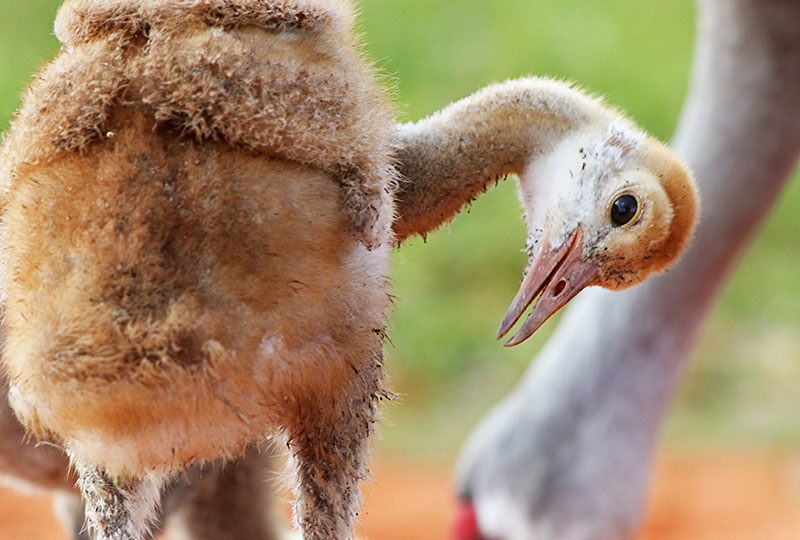
I'm all eyes!
Lol, your sandhill crane picture reminded me of this shot I took a couple of years ago:

